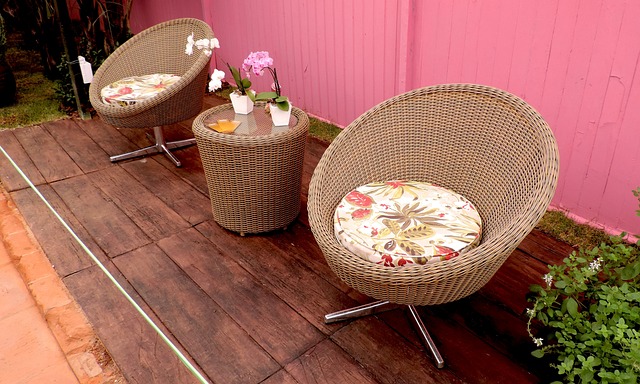Outdoor cushions can be a great addition to any outdoor space, providing comfort and style to your patio or deck. However, one of the most common questions people have about outdoor cushions is whether they can get wet. In this article, I will explore the different types of outdoor cushions, whether they can get wet, what happens when they do, and how you can protect and clean them to ensure they last for years to come.
Can Outdoor Cushions Get Wet?
Outdoor cushions can get wet, but whether or not they can withstand exposure to water depends on the type of outdoor cushion you have. There are two main types of outdoor cushions: waterproof and water-resistant.
Waterproof outdoor cushions are designed to withstand exposure to water without becoming saturated or allowing moisture to seep into the filling. These cushions are typically made of materials such as vinyl or polyester, and they are ideal for use in areas that are prone to rain or high humidity.
Water-resistant outdoor cushions, on the other hand, are designed to resist water to a certain extent but are not completely waterproof. These cushions are typically made of materials such as Sunbrella, which is a highly durable fabric that resists water, mold, and fading.
Before purchasing outdoor cushions, it’s important to consider the climate in your area and the intended use of the cushions. If you live in an area that receives a lot of rain or high humidity, it may be best to invest in waterproof cushions to ensure they remain in good condition. If you live in a drier climate or plan to use the cushions in a covered outdoor area, water-resistant cushions may be a suitable option.
What Happens When Outdoor Cushions Get Wet?
When outdoor cushions get wet, they can experience several problems that may impact their appearance, comfort, and longevity. Here are some of the things that can happen:
- Mold and mildew: Moisture can create the perfect breeding ground for mold and mildew, which can thrive on the fabric, foam, or stuffing inside the cushion. Not only can mold and mildew create an unpleasant odor, but they can also cause health problems for those who are allergic to them.
- Fading and discoloration: Exposure to water and UV rays can cause outdoor cushions to fade or discolor over time. This can make the cushions look old and worn out, even if they are still comfortable to use.
- Damage to the cushions’ filling: When outdoor cushions get wet, the water can seep into the foam or stuffing inside the cushion, causing it to become saturated and heavy. This can make the cushions uncomfortable to sit on and can also cause the filling to break down over time.
- Shortened lifespan of the cushions: All of these problems can combine to reduce the lifespan of outdoor cushions, making them wear out more quickly than they would if they were kept dry and well-maintained.
It’s important to take steps to protect your outdoor cushions from getting wet to prevent these problems from occurring.
How to Protect Your Outdoor Cushions From Getting Wet
Protecting your outdoor cushions from getting wet can help prevent mold, mildew, fading, and damage to the cushions’ filling, extending their lifespan. Here are some ways to protect your cushions from getting wet:
- Cover your cushions with waterproof covers: One of the simplest ways to protect your outdoor cushions from getting wet is to cover them with waterproof covers. These covers are designed to keep out moisture, preventing it from seeping into the cushions. When not in use, you can remove the covers to enjoy the cushions.
- Store your cushions indoors during wet seasons: If you live in an area that experiences heavy rain or high humidity, it may be best to store your outdoor cushions indoors during the wet seasons. This will help prevent them from getting wet and minimize the risk of mold and mildew growth.
- Choose a suitable location for your outdoor cushions: When placing your outdoor cushions, try to choose a location that is protected from rain and direct sunlight. A covered patio or a shaded area under a tree are good options. Avoid placing your cushions in areas that are prone to flooding or where water tends to accumulate.
- Apply a water-resistant coating to your outdoor cushions: If you have water-resistant cushions, you can further protect them by applying a water-resistant coating. This will help repel water and keep the cushions dry even in light rain.
How to Clean Wet Outdoor Cushions
If your outdoor cushions do get wet, it’s important to clean them as soon as possible to prevent mold and mildew growth. Here’s how to clean wet cushions:
- Remove excess water: If your cushions are wet, start by removing any excess water by blotting them with a towel or using a wet-dry vacuum to extract the water from the cushions.
- Spot cleaning with mild detergent: Next, spot clean the cushions with mild detergent and warm water. You can use a soft-bristled brush to gently scrub the cushions and remove any stains. Rinse the cushions thoroughly with clean water and allow them to air dry.
- Deep cleaning with a pressure washer: For more heavily soiled cushions, you may need to use a pressure washer to deep clean them. Be sure to use a low-pressure setting and a mild detergent, and avoid getting too close to the cushions to prevent damage. Rinse the cushions thoroughly with clean water and allow them to air dry.
- Drying outdoor cushions: It’s important to allow your outdoor cushions to dry completely before using them again. You can place them in a sunny, well-ventilated area or use a fan to help speed up the drying process. Avoid using a clothes dryer, as the heat can damage the cushions.
Conclusion
In conclusion, outdoor cushions can get wet, but whether or not they can withstand exposure to water depends on the type of cushion you have. Waterproof cushions are designed to withstand exposure to water, while water-resistant cushions are designed to resist water to a certain extent.
When outdoor cushions get wet, they can experience problems such as mold and mildew, fading and discoloration, damage to the cushions’ filling, and a shortened lifespan. To protect your outdoor cushions from getting wet, you can cover them with waterproof covers, store them indoors during wet seasons, choose a suitable location for them, and apply a water-resistant coating.
If your cushions do get wet, it’s important to clean them promptly to prevent mold and mildew growth. By removing excess water, spot cleaning with mild detergent, deep cleaning with a pressure washer, and allowing the cushions to dry completely, you can keep your outdoor cushions looking and feeling like new for years to come.
Here is another article to read on wet furniture.








